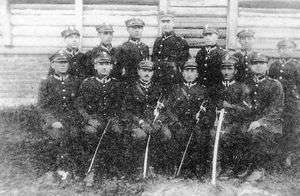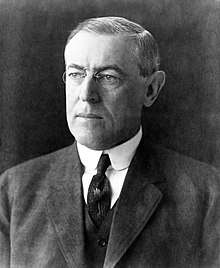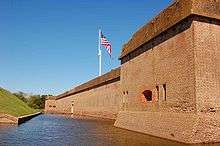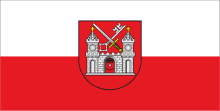Polonophile
A Polonophile, less often Polophile,[1][2] is an individual who respects and is fond of Poland's culture as well as Polish history, traditions and customs. The term defining this kind of attitude is Polonophilia. The antonym and opposite of Polonophilia is Polonophobia.
.svg.png)

History
Duchy and Kingdom of Poland
The history of the concept dates back to the beginning of the Polish state in 966 AD under Duke Mieszko I. It remained strong among ethnic minorities as in allied neighbouring countries and during Polonization of the Eastern Borderlands, Livonia, Silesia and other acquired territories implied by the Polish Crown or the Polish government, thus also triggering Polonophobia.[3][4][5]
One of the first recorded potential Polonophiles were exiled Jews which settled in Poland throughout the Middle Ages, particularly following the First Crusade between 1096 and 1099.[6] The culture and intellectual output of the Jewish community in Poland had a profound impact on Judaism as a whole over the next centuries, with both cultures becoming somewhat inter-connected and influenced by each other. Jewish historians claimed that the name of the country is pronounced as "Polania" or "Polin" in Hebrew, and this was interpreted as a good omen because Polania can be divided into three separate Hebrew words: po (here), lan (dwells), ya (God), and Polin into two words: po (here) lin ([you should] dwell).[7] This suggested that Poland was a good destination for the Jews fleeing from persecution and anti-Semitism in other European countries. Rabbi David HaLevi Segal (Taz) expressed his pro-Polish views by stating that Poland is a place where "most of the time the gentiles do no harm; on the contrary they do right by Israel" (Divre David; 1689).[8] Ashkenazi Jews willingly adopted some aspects of Polish cuisine, language and the Polish national dress, which can be seen in Orthodox Jewish communities around the world.[9][10]
Polish–Lithuanian Commonwealth
When Stephen Bathory, King of Poland, captured Livonia (Truce of Jam Zapolski), he granted the city of Tartu (Polish name: Dorpat) in contemporary Estonia its own banner with the colours and layout resembling the Polish flag. The flag dating from 1584 is still in use today.[11]
When the Poles invaded the Tsardom of Russia in 1605, a self-identified prince known as False Dmitry I assumed the Russian throne. A Polonophile, he assured that king Sigismund III of Poland would be able to control the country's internal and external affairs and secure Russia's conversion to Catholicism, thus making it a puppet state. Dmitry's murder was a possible justification for arranging a full-scale invasion by Sigismund in 1609. The Seven Boyars deposed reigning Tsar Boris Godunov to demonstrate their support for the Polish cause. Godunov was transported as a prisoner to Poland where he died.[12] In 1610, the Boyars elected Sigismund's underage son Władysław as the new Tsar of Russia, however, he was never crowned.[13] This period was known as the Time of Troubles, a major part in Russia's history which remains relatively unspoken of in Polish historiography due to implied Polonization policies.

During the times of the Polish–Lithuanian Commonwealth, the Zaporizhian Cossack state was allied to the Catholic King of Poland and the Cossacks were often hired as mercenaries. This had a strong impact on the Ukrainian language and led to the establishment of a functioning Ukrainian Greek Catholic Church in 1596 at the Union of Brest.[14] The Ukrainians, however, retained their Orthodox Christian faith and the Cyrillic alphabet. During the Russo-Polish War of 1654–1667 the Cossacks were divided into the pro-Polish (Right-bank Ukraine) and pro-Russian (Left-bank Ukraine) factions. Petro Doroshenko, who commanded the army of Right-bank Ukraine, as well as Pavlo Teteria and Ivan Vyhovsky were open Polonophiles allied to the Polish king.[15] The Polish influence on Ukraine ended with the Partitions in the late 18th-century when the territory of contemporary Ukraine was annexed by the Russian Empire.[16]
Under John III Sobieski the Christian coalition forces defeated the Ottoman Turks at the Battle of Vienna in 1683, which ironically sparked admiration for Poland and its Winged Hussars in the Ottoman Empire. The Sultan named Sobieski the "Lion of Lehistan [Poland]".[17] This tradition was cultivated when Poland disappeared from map for 123 years; the Ottoman Empire, along with Persia, was the only major country in the world which did not recognize the Partitions of Poland.[18] The reception ceremony of a foreign ambassador or a diplomatic mission in Istanbul began with an announcement sacred formula: “the Ambassador of Lehistan [Poland] has not yet arrived".[19]
After Partitions

The Partitions, which arguably occurred due to Poland's previous conquests, gave a rise to a new wave of Polonophilia in Europe and the world. Exiled revolutionaries such as Casimir Pulaski and Tadeusz Kościuszko, who fought for the independence of the United States from Britain, relatively contributed to pro-Polish sentiment in North America.[20][21]
When Belgium declared independence from the Netherlands, Belgian diplomats refused to establish diplomatic relations with the Russian Empire as it annexed a large portion of Poland's eastern territories during the Partitions.[22] Diplomatic relations between Moscow and Brussels were established after some decades.[23]
The November Uprising in Congress Poland in 1830 against Russia prompted a wave of polonophilia in Germany, including financial contributions to exiles, the singing of pro-Polish songs, and pro-Polish literature. By the time of the January Uprising in 1863, however, this polonophile sentiment had mostly vanished.[24]

One of the most prominent and self-declared Polonophiles of the late 19th-century was German philosopher Friedrich Nietzsche. Nietzsche, who was certain of his Polish heritage,[25] often expressed his positive views and admiration towards Poles and their culture. Despite this, modern scholars believe that Nietzsche's claim of Polish ancestry is a pure invention.[26] According to biographer R. J. Hollingdale, Nietzsche's propagation of the Polish ancestry myth may have been part of his "campaign against Germany".[27]
One of the strongest centres of Polonophilia in 19th-century Europe was Ireland.[28] The Young Ireland movement as well as the Fenians saw similarities between the two countries, as Catholic nations and victims of larger Imperial powers. In 1863, Irish newspapers expressed wide support for the January Uprising, which was seen as a risky move at the time.[28]
Throughout modern history, France was long Poland's ally, especially after Louis XV married Polish princess Marie Leszczyńska, the daughter of Stanislaus I. Certain Polish customs and fashion became popular in the Versailles such as the Polonaise dress (robe à la polonaise) which was adored by Marie Antoinette. Polish cuisine and ways of cooking also became known in French as à la polonaise. Both Napoleon I and Napoleon III expressed strong pro-Polish sentiment after Poland ceased to exist as a sovereign country in 1795.[29][30] In 1807, Napoleon I established the Duchy of Warsaw, a client state of the French Empire which dissolved in 1815 at the Congress of Vienna. Napoleon III also called for a free Poland and his consort, Eugénie de Montijo, astonished the Austrian ambassador (Austria was one of three partitioning powers) by "unveiling a European map with a realignment of borders to accommodate independent Poland".[31]
When Poland finally regained its independence following World War I, Polonophilia gradually transformed into a demonstration of patriotism and solidarity, especially during the horrors of World War II and struggle against communism.
Silesia

One of the regions which demonstrated its Polish identity was the ethnic Silesian minority in Upper Silesia which was subjected to systematic Germanisation and conversion to Protestantism under the German Empire.[32] After the Polish nation-state was founded in 1918, Germany's Regency of Oppeln (Upper Silesia) rebelled in solidarity with the Second Polish Republic what became known as the Silesian Uprisings.[33][34] An easternmost sliver of the region became part of the Polish Republic in 1922, and the Polish Government had decided to grant this German territory autonomy in 1919 with the Silesian Parliament as a constituency and the Silesian Voivodeship Council as the executive body.[35]
After World War II, the whole of Upper Silesia and German Lower Silesia were assigned to Poland in accordance with the Potsdam Agreement. Expulsions and forced polonization followed.[36] [37] To this day some Silesians identify as Polish or German citizens and cultivate their Catholic traditions, simultaneously preserving their unique and separate identity.[38]
Contemporary
Armenia
Armenians in Poland have an important and historical presence which dates back to the 14th century,[39] however, the first Armenian settlers arrived in the 12th century which makes them the oldest minority in Poland with the Jews.[40] A very significant and independent Armenian diaspora existed in Poland but was assimilated over the centuries due to Polonization and the absorption of Polish culture. Between 40,000 and 80,000 people in Poland today either claim Armenian nationality or Armenian heritage.[41] Mass waves of Armenian immigration to Poland began after the collapse of the Soviet Union in 1991 and continues to this day.[41][42]
Armenians are highly fond of Polish culture and history.[43] Several Armenian cultural features also exist in the Polish national dress, most notably the Karabela sabre introduced by Armenian merchants under Poland-Lithuania.
Georgia

Many Georgians participated in military campaigns led by Poland in the 17th century. Bogdan Gurdziecki, an ethnic Georgian, became the Polish king's ambassador to the Middle East and made frequent diplomatic trips to Persia to represent Polish interests. During the war in South Ossetia in 2008, also known as the Russo-Georgian War, Poland strongly supported Georgia. The President of Poland, Lech Kaczyński, flew to Tbilisi to rally against the Russian military intervention and subsequent military conflict. Several European leaders met with Georgian president Mikheil Saakashvili at Kaczyński's initiative at the rally held on 12 August 2008 which was attended by over 150,000 people. The crowd responded enthusiastically to the Polish president's speech, chanting "Poland, Poland", "Friendship, Friendship" and "Georgia, Georgia".[44]
The main boulevard in the city of Batumi, Georgia, is named after Lech Kaczyński and his wife Maria.[45]
Hungary
Hungary and Poland have enjoyed good relations since the inauguration of diplomatic relations between the two countries in the Middle Ages.[46] Hungary and Poland have maintained a very close friendship and brotherhood "rooted in a deep history of shared monarchs, cultures, and common faith". Both countries commemorate a fraternal relationship and Friendship Day.
In World War II, Hungary refused to allow Hitler's troops to pass through the country during the Invasion of Poland in September 1939. Simultaneously, Hungary, which under Miklós Horthy was allied with Nazi Germany, declined to participate in the invasion as a matter of "Hungarian honour".[47]
On 12 March 2007, Hungary's parliament declared 23 March the "Day of Hungarian-Polish Friendship", with 324 votes in favor, none opposed, and no abstentions. Four days later, the Polish parliament declared 23 March the "Day of Polish-Hungarian Friendship" by acclamation. The Parliament of Hungary also voted 2016 as the Year of Hungarian-Polish solidarity.[48]
Hungarian-born prince Stephen Báthory, who was elected King of Poland in 1576, is the primary figure of the close ties between the countries.
Italy
Because Italy and Poland shared common historical backgrounds and common enemies (Austria), a good relationship is maintained to this day. After the Revolutions of 1848 in the Italian states against the Austrian Empire, Francesco Nullo, a merchant by trade, travelled to Poland to aid the Poles in the January Uprising against Russia. He was killed at the Battle of Krzykawka in 1863 fighting for Poland's independence.[49] In Poland, Nullo is a national hero and numerous streets and schools are named in his honour.[50]
The struggle for a united and sovereign nation was a common goal for both countries and it was noticed by Goffredo Mameli, a Polonophile and the author of the lyrics in the Italian national anthem – Il Canto degli Italiani.[51] Mameli featured a prominent statement in the last verse of the anthem – Già l'Aquila d'Austria, le penne ha perdute. Il sangue d'Italia, il sangue Polacco... translated as "Already the Eagle of Austria has lost its plumes. The blood of Italy, the Polish blood...".
Pope John Paul II also greatly contributed to a favourable opinion of the Polish people in Italy and in the Vatican during his pontificate.[52]
United Kingdom
_Squadron_RAF_with_one_of_their_Hawker_Hurricanes%2C_October_1940._CH1535.jpg)
The United Kingdom has long supported Poland and the cause of Polish independence, though Poland has never historically been a main UK foreign policy concern. It wasn't until the 20th century that UK-Poland relations intensified with the signing of an Anglo-Polish military alliance in 1939. During WW2 the UK hosted the Polish Government-in-Exile (which remained in London until Polish Independence in 1991) and approximately 250,000 Polish people served with British forces taking part in many key campaigns. One twelfth of all pilots in the Battle of Britain were Polish, with many Brits even today recognising Polish efforts during the war. Polish-UK relations hit a deep low after the Yalta conference and subsequent post-war alteration of Poland's borders, but Polish servicemen and women were allowed to remain in the UK under the Polish Resettlement Act rather than being forced to face possible arrest and death upon return to now Communist Poland. The work of the Polish post-war diaspora resulted in the establishment of Polish cultural clubs and societies in major UK cities, many of which still survive today, and a growing acceptance of the Polish community within the UK. After Poland joined the EU in 2004 a new wave of migration reinvigorated the diaspora with approximately 832,000 Polish-born people living in the UK in 2018; however, the initial migration also caused tensions with local communities over possible competition for jobs and language barriers. While Brexit resulted in some anti-Polish sentiment, Poles and their contribution to the UK are increasingly positively regarded by Brits, with the Polish Embassy in London coordinating annual 'Polish Heritage Day' events to highlight Polish culture in the UK and to build closer ties with local British communities.
United States


Tadeusz Kościuszko and Casimir Pulaski, who fought for the independence of the United States and Poland, are seen as the foundation of Polish-American relations. However, the United States began to be involved in Poland's struggle for sovereignty during the two Uprisings that took place in the 19th-century.
When the November Uprising started in 1830, there was only a very small number of Poles in the United States, but the views of Poland were shaped positively by their support for the American Revolution. Several young men offered their military services to fight for Poland, the most well-known of which was Edgar Allan Poe who wrote a letter to his commanding officer on 10 March 1831 to join the Polish Army should it be created in France. Support for Poland was highest in the South, as Pulaski's death in Savannah, Georgia was well-remembered and memorialized. The most famous landmark representing American Polonophilia of the time was Fort Pulaski in the state of Georgia.
Włodzimierz Bonawentura Krzyżanowski was another hero who fought at Gettysburg and helped to repel the Louisiana Tigers. He was appointed the governor of Alabama, Georgia and served as administrator of Alaska Territory, a high distinction for a foreigner at the time. He fled Poland after the failed 1848 Greater Poland Uprising.

Strong support for Poland and pro-Polish sentiment was also observed in Woodrow Wilson, the 28th President of the United States, who in 1918 delivered his Fourteen Points as peace settlement to end World War I and demanded in the 13th point that "an independent Polish state should be erected...with a free and secure access to the sea...".[53][54]
Donald Trump also expressed his sentiment towards Poland and Polish history in his speech in Warsaw on 6 July 2017. Trump spoke highly of the spirit of the Polish for defending the freedom and independence of the country several times at the speech, notably the unity of Poles against the oppression of communism. He applauded the Poles’ prevailing spiritual determination, and recalled the gather of the Poles in 1979 that created the famous chant "We want God".[55] Trump also made remarks on Polish economic success and policies towards migrants.[55]
The large Polish-American community maintains some traditional folk customs and contemporary observances, such as Dyngus Day and Pulaski Day, which became well known in American culture. This also includes the influence of Polish cuisine and the spread of famous specialties from Poland like pierogi, kielbasa, Kabana sausage and bagels.[56]
See also
- Polonophobia
- Polish American
- History of Poland
- Polonization
References
- Poland’s president on NATO, his critics and the burden of history, Maclean's, Paul Wells, 12 May 2016
- World of Our Fathers, New York University Press, By Irving Howe & Kenneth Libo, 2005 reprint of 1976 original, page 514
- Naimark, Norman M. (22 May 2019). Fires of Hatred. Harvard University Press. ISBN 9780674009943. Retrieved 22 May 2019 – via Google Books.
- Thum, Gregor (8 August 2011). Uprooted: How Breslau Became Wroclaw during the Century of Expulsions. Princeton University Press. ISBN 978-1400839964. Retrieved 22 May 2019 – via Google Books.
- Krapauskas, Virgil (22 May 2019). Nationalism and Historiography: The Case of Nineteenth-century Lithuanian Historicism. East European Monographs. ISBN 9780880334570. Retrieved 22 May 2019 – via Google Books.
- "Poland Virtual Jewish History Tour". www.jewishvirtuallibrary.org. Retrieved 22 May 2019.
- Salamensky, Shelley (6 December 2014). "Poland's Jews: Under a New Roof". Retrieved 22 May 2019.
- David ben Samuel Ha-Levi, "Divre ̄ David Ture ̄ Zahav" (1689) in Hebrew. Published in: Bi-defus Y. Goldman, Warsaw: 1882. Quoted by the YIVO Encyclopedia of Jews in Eastern Europe.
- Treats, Jewish. "Shtreimels and Spodiks". Retrieved 22 May 2019.
- "Jewish Historical Institute". www.jhi.pl. Retrieved 22 May 2019.
- "The Flag and the Coat of Arms of Tartu". Tartu linn. Retrieved 22 May 2019.
- Robert O. Crummey, The Formation of Muscovy 1304–1613 (New York and London: Longman, 1987), pp. 224–5.
- Bohun & Rosalak 2007, p. 8.
- "Union of Brest-Litovsk". Encyclopedia Britannica. Retrieved 22 May 2019.
- Stone, Daniel Z. (1 July 2014). The Polish-Lithuanian State, 1386-1795. University of Washington Press. ISBN 9780295803623. Retrieved 22 May 2019 – via Google Books.
- "Poland - The Three Partitions, 1764-95". countrystudies.us. Retrieved 22 May 2019.
- Mario Reading (2009). The Complete Prophecies of Nostradamus. Sterling Publishing Company, Inc. p. 382. ISBN 978-1-906787-39-4.
- "Edukacja Międzykulturowa: Turcy" (PDF). Archived from the original (PDF) on 3 July 2010. (48.9 KB)
- "T.C. Dışişleri Bakanlığı Turkish Embassy In Warsaw". warsaw.emb.mfa.gov.tr. Retrieved 22 May 2019.
- Kajencki, AnnMarie Francis (15 August 2004). Count Casimir Pulaski: From Poland to America, a Hero's Fight for Liberty. The Rosen Publishing Group, Inc. ISBN 9781404226463. Retrieved 22 May 2019 – via Google Books.
- Fanelli, Doris Devine; Diethorn, Karie (22 May 2019). History of the Portrait Collection, Independence National Historical Park. American Philosophical Society. ISBN 9780871692429. Retrieved 22 May 2019 – via Google Books.
- "BTNG". SOMA-CEGES. 22 May 2019. Retrieved 22 May 2019 – via Google Books.
- Tavernier, Roger (22 May 2019). Russia and the Low Countries: An International Bibliography, 1500-2000. Barkhuis. ISBN 9789077089040. Retrieved 22 May 2019 – via Google Books.
- Healy, Róisón (2014). "From Commonwealth to Colony? Poland under Prussia". In Healy, Róisín; Dal Lago, Enrico (eds.). The Shadow of Colonialism on Europe’s Modern Past. p. 116. ISBN 9781137450746.
- Mencken, Henry Louis (1913). Friedrich Nietzsche. Transaction Publishers. p. 6. ISBN 978-1-56000-649-7.
- Mencken, Henry Louis (2003), The Philosophy of Friedrich Nietzche, introd. & comm. Charles Q. Bufe, US: See Sharp Press, p. 2
- Hollingdale 1999, p. 6.
- Whelehan, Niall (3 October 2014). Transnational Perspectives on Modern Irish History. Routledge. ISBN 9781317963226. Retrieved 22 May 2019 – via Google Books.
- Wieczerzak, Joseph W. (22 May 1967). "A Polish chapter in Civil War America: the effects of the January insurrection on American opinion and diplomacy". Twayne Publishers. Retrieved 22 May 2019 – via Google Books.
- Walsh, Warren Bartlett (22 May 2019). "Russia and the Soviet Union: a modern history". University of Michigan Press. Retrieved 22 May 2019 – via Google Books.
- Cassels, Alan (1 November 2002). Ideology and International Relations in the Modern World. Routledge. ISBN 9781134813308. Retrieved 22 May 2019 – via Google Books.
- Lojk¢, Mikl¢s (1 January 2006). Meddling in Middle Europe: Britain and the 'Lands Between, 1919-1925. Central European University Press. ISBN 9789637326233. Retrieved 22 May 2019 – via Google Books.
- Karch, Brendan (4 October 2018). Nation and Loyalty in a German-Polish Borderland: Upper Silesia, 1848–1960. Cambridge University Press. ISBN 9781108487108. Retrieved 22 May 2019 – via Google Books.
- Karch, Brendan (4 October 2018). Nation and Loyalty in a German-Polish Borderland: Upper Silesia, 1848–1960. Cambridge University Press. ISBN 9781108487108. Retrieved 22 May 2019 – via Google Books.
- "Silesian Parliament in Katowice". www.polandtraveltours.com. Retrieved 22 May 2019.
- T Kamusella & M Nomachi. 2014. The Long Shadow of Borders: The Cases of Kashubian and Silesian in Poland (pp 35-59). Eurasia Border Review. Vol 5, No 2
- T Kamusella. Ethnic Cleansing in Silesia 1950-89 and the Ennationalizing Policies of Poland and Germany (pp 51-74). 1999. Patterns of Prejudice. No 2.
- Kamusella, Tomasz (22 May 2019). Silesia and Central European Nationalisms: The Emergence of National and Ethnic Groups in Prussian Silesia and Austrian Silesia, 1848-1918. Purdue University Press. ISBN 9781557533715. Retrieved 22 May 2019 – via Google Books.
- "Epilogue - History of Armenia". www.armenica.org. Retrieved 22 May 2019.
- "Polish Armenians, one of the oldest minorities living in Poland". POLANDDAILY.COM. 17 January 2019. Retrieved 22 May 2019.
- "Armenians in Poland: From the Middle Ages to the Modern Day". 12 July 2018. Retrieved 22 May 2019.
- "Armenia - Administration and social conditions". Encyclopedia Britannica. Retrieved 22 May 2019.
- Gatrell, Peter (22 May 2019). "Displacing and Re-Placing Population in the Two World Wars: Armenia and Poland Compared". Contemporary European History. 16 (4): 511–527. doi:10.1017/S0960777307004158. JSTOR 20081381.
- "Lech Kaczyński: jesteśmy tu po to, by podjąć walkę". Rzeczpospolita (in Polish). 12 August 2008. Archived from the original on 11 January 2012. Retrieved 4 January 2012.
- "Georgian Port City Renames Street After Late Polish President". RadioFreeEurope/RadioLiberty. Retrieved 22 May 2019.
- "The alliance between Poland and Hungary is a historic one – miniszterelnok.hu". www.miniszterelnok.hu. Retrieved 22 May 2019.
- Józef Kasparek, "Poland's 1938 Covert Operations in Ruthenia", p. 370.
- "Uchwała Sejmu Rzeczypospolitej Polskiej z dnia 16 marca 2007 r. w sprawie ustanowienia dnia 23 marca Dniem Przyjaźni Polsko-Węgierskiej". orka.sejm.gov.pl. Retrieved 22 May 2019.
- Gentes, Andrew A. (20 October 2017). The Mass Deportation of Poles to Siberia, 1863-1880. Springer. ISBN 9783319609584. Retrieved 22 May 2019 – via Google Books.
- "Polish Literature: Littérature Polonaise". Authors Agency. Agence des auteurs. 22 May 1969. Retrieved 22 May 2019 – via Google Books.
- Guttry, Andrea De; Capone, Francesca; Paulussen, Christophe (30 March 2016). Foreign Fighters under International Law and Beyond. Springer. ISBN 9789462650992. Retrieved 22 May 2019 – via Google Books.
- "Yearbook of Polish Foreign Policy". Polish Institute of International Affairs. 22 May 2019. Retrieved 22 May 2019 – via Google Books.
- Biskupski, M. B. B. (1 August 2011). Hollywood's War with Poland, 1939-1945. University Press of Kentucky. ISBN 978-0813139326. Retrieved 22 May 2019 – via Google Books.
- Poetker, Joel S. (22 May 1969). "The Fourteen Points". C. E. Merrill. Retrieved 22 May 2019 – via Google Books.
- "Remarks by President Trump to the People of Poland". whitehouse.gov. 6 July 2017. Retrieved 5 November 2018.
- Tribune, Monica Kass Rogers, Special to the. "Pierogi, yes, but there's so much more". chicagotribune.com. Retrieved 22 May 2019.
